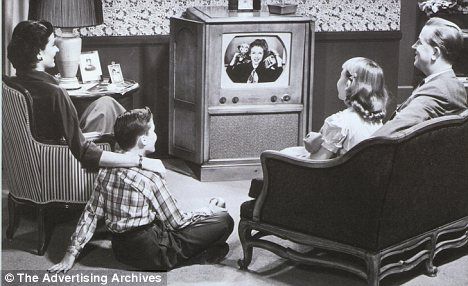I have long believed Americans need to shut off the mass media and pay close attention to what it is science has learned about the mind. Too many people, despite the obvious efforts of the media to propagandize us, still cling to their chosen brand of news as a reliable source of information. They don’t consider the fact that media itself is a tool of societal transformation, meant to shape and guide the perceptions of the public. When writing and conducting research on the topic, I look for sources that convey similar messages that span across time. For Instance, Joost Meerloo, a psychologist who studied the effects of propaganda on Nazi prisoners stated in Rape of the Mind (p.22), that propaganda is meant to condition man’s mind to a narrow, totalitarian concept of the world. Compare that statement to one in a book published forty years later called Media Effects: Advances in Theory and Research. On the very first page, the authors discuss the agenda-setting role of the media and how they have been successful in defining what the public thinks about. They are not claiming to control what the public thinks or their opinions, but what dominates their minds. What they are thinking about.
“Establishing this salience among the public so that an issue becomes the focus of public attention, thought, and perhaps even action is the initial stage in the formation of public opinion. Although many issues compete for public attention, only a few are successful in reaching the public agenda. The news media exert a significant influence on our perceptions of what are the most salient issues of the day.” (McCombs & Reynolds, 2002, pg. 1)
Look at that last line in the above quote and compare that to Meerloo’s quote from Rape of the Mind. If there is any truth to what he is saying about propaganda being used to condition man’s mind to a narrow, totalitarian concept, wouldn’t the news media be used to do it? The media controls what we are thinking about and what we are debating as a society. By controlling what we are focusing on, they can better guide our perceptions towards an end that is useful to them. They are limiting our understanding of the issues to a “narrow totalitarian concept.”
Let’s look at a couple of other quotes. On page 67 of Rape of the Mind, Meerloo says that “communication specialists and public-opinion engineers, have concluded through decades of study that propaganda can be successful in creating any perception while also providing the illusion that people are freely choosing their own opinions.” When the mainstream media is made up of mostly liberal, and one so-called, mainstream conservative outlet, they are doing exactly that. They are controlling information while keeping it within acceptable limits that give the illusion that we are freely choosing our opinions. This idea can be better explained by looking at Noam Chomsky’s book Manufacturing Consent: The Political Economy of the Mass Media. He states that “media policy itself may allow some measure of dissent and reporting that calls into question the accepted viewpoint.” (pg. XU) He goes on to say that differing viewpoints, which steer away from the perception of popular opinion, are allowed to exist with certain “bounds and margins” so the system doesn’t give the appearance of being controlled from the top down, and so the differing viewpoints are not large enough to interfere with the official agenda.
Americans are scantly aware of the research that has gone into this. It has long been believed by media researchers that mass media communications have had little effect on shaping public perception. According to McComb and Reynolds (pg.2) earlier studies into the effectiveness of persuading media audiences to change their opinions or attitudes towards certain topics were not effective because, at the time, media was more likely to take an objective, straightforward approach to reporting the news. The term agenda-setting came about after it was discovered, through “decades of exploring the cognitive, long-term implications of daily journalism” (McCombs & Reynolds, pg.2), that people’s perceptions of the news were not only based on how factual or informative the story was, but by how certain aspects of the story were emphasized. Another way to describe this is by saying the story was framed in a certain way to influence opinion and attitude change. This led to a better understanding of how media could be used to shape perceptions and guide public opinion toward an end suitable to those setting the agenda.
What does it mean to frame an issue? According to the book Dynamics of Persuasion: Communications and Attitudes in the 21st Century, a frame is a way to present stories from the point of a “perceived reality and make them more salient in a communicating text in such a way as to promote a particular problem definition, causal interpretation, moral evaluations, and/or treatment options” (p. 349). Research has found that framing issues through certain points of view can be very successful in producing compliance, and or attitude change (p. 349). This is because people are not the deep thinkers, they believe they are. Cass Sunstein states in his book Nudge, (p. 37) that people lack the ability to see if their reaction to a particular message would change if it was framed in a different way. One reason, he states, is because they wouldn’t know what to make of the contradictions that would arise.
The best example that puts all of this information into perspective is when Fox News, the mainstream conservative outlet, ran a story promoting the importance of understanding transgender issues. This is an example of framing from the perspective of a research model called Moral Foundations Theory. This is a method of study used to determine how to present a topic that may be rejected by a certain audience in a way that aligns with their moral worldviews. One study, which used this model, claims to show that conservatives are more likely to shift their opinions to the left, than liberals to the right, if the story is framed in a way that aligns with their morals. This is also called a purity to worldview standard. By presenting issues of a left-wing nature to a right-wing audience in a way that emphasizes personal freedom and liberty for all, they can slightly shift the attitudes of the right into accepting what they would otherwise reject. Or at the very least, think differently about the topic. This aligns with what Edward Bernays said in his book, simply entitled, Propaganda. He states that it is now possible to mold the minds of the masses so that they will direct all their efforts towards the desired ends of the shadow government, which use the powers of propaganda to gain approval from the people on issues they may have, at one time, disapproved of (pg.19).
The bigger point of this article that I tried to get across is that there are several resources that convey similar messages about the nature of media that Americans should be paying attention to. If, for example, I read in one book written over sixty years ago, that propaganda is meant to control the perceptions of the public and keep their opinions trapped in a “narrow totalitarian worldview,” and in another published nearly half a century later, that the media has been successful in controlling what it is the public thinks about, I should investigate this further. When several different sources are claiming that media can be used to create the perception that we are freely choosing our own opinions, and that media messages can be framed in a way to influence our opinions, they should be taken at their word. Decades of study have gone into understanding how the human mind responds to media messaging, and a great deal of work is being done to understand how to persuade people into changing their opinions (Meerloo, pg.67). Especially when it comes to politics and pushing the national agenda. Which anyone can see is very left-wing in nature. In other words, the propagandists and the brainwashers have essentially told us what they can do. Yet, millions of us continue to watch the news as if they are being honest with us.
Check out my latest book on Critical Race Theory Now available in paperback.

Also, check out Without a Shot Indeed: Inducing Compliance to Tyranny Through Conditioning and Persuasion.
























